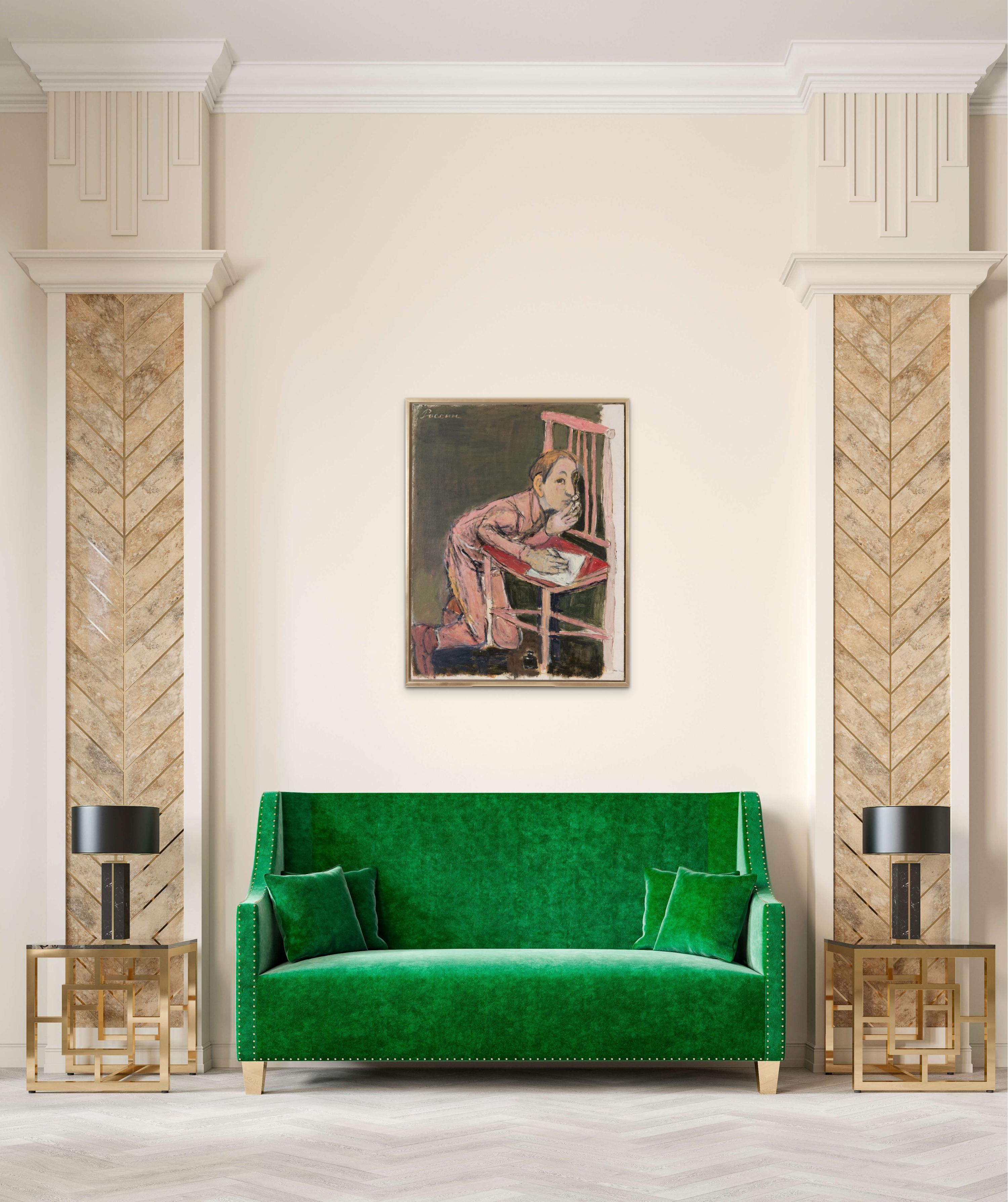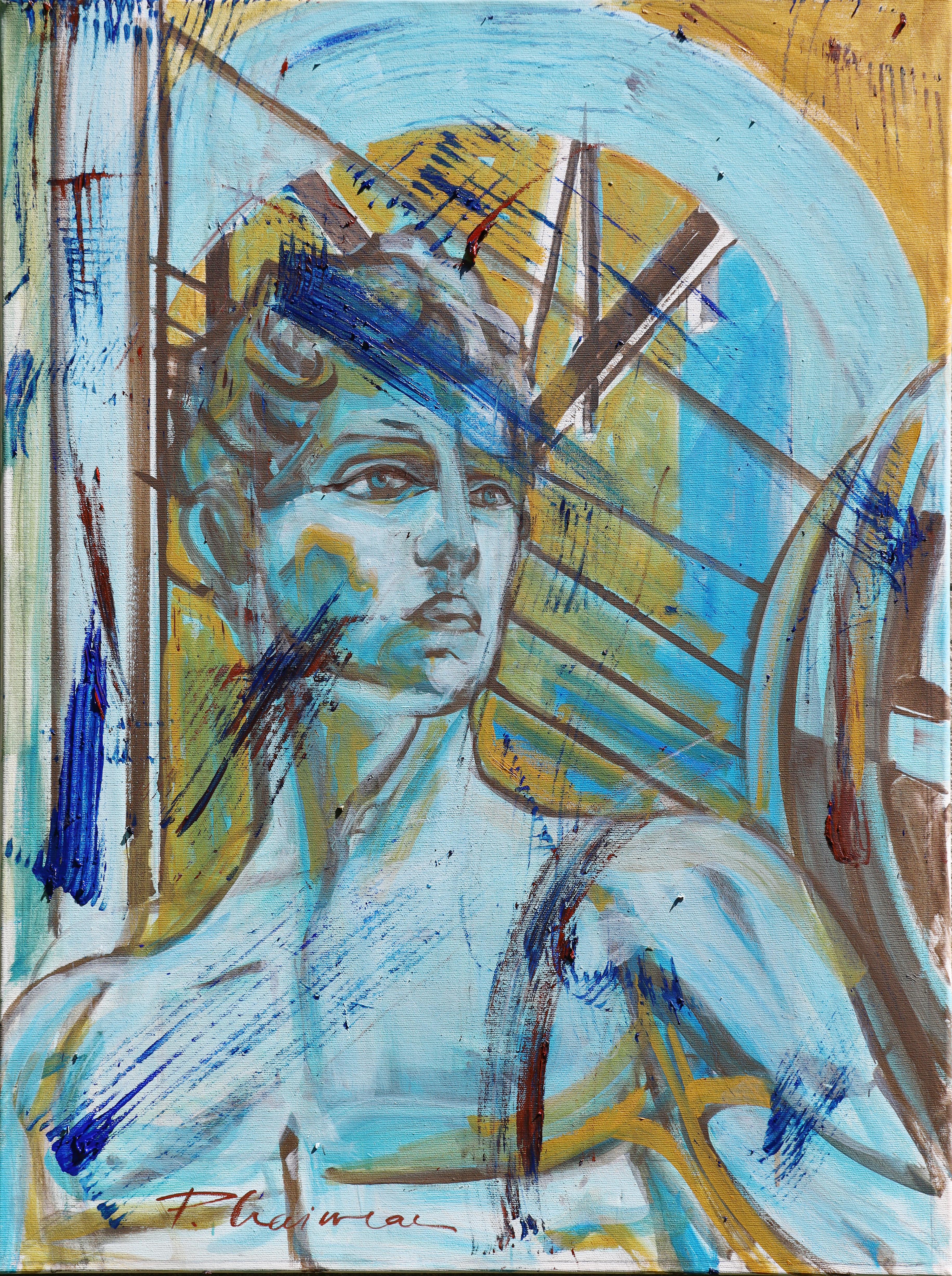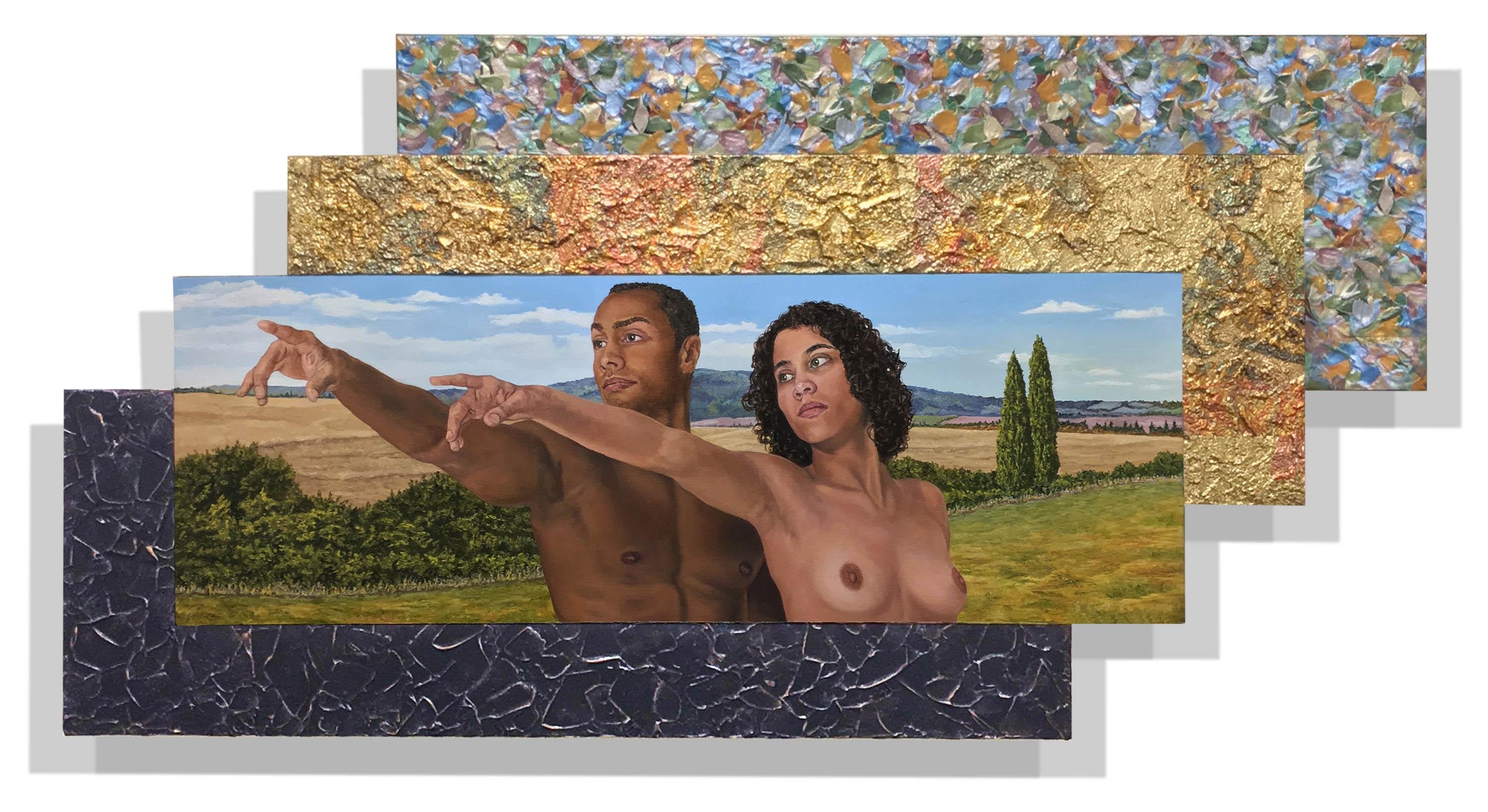Items Similar to The Violinist
Want more images or videos?
Request additional images or videos from the seller
1 of 8
Denes de HoleschThe Violinist
About the Item
Denes Holesch
Hungarian, 1910-1983
The Violinist
Oil on board
26 ½ by 22 in. W/frame 33 by 28 ½ in.
Denes Holesch (Denes de Holesch) was born in 1910 in Besztercebanya, Hungary. He entered the Academy of Fine Arts as a Hungarian with a Czechoslovakian passport, since Hungary was divided after the Trianon Treaty in 1920. That frustrating feeling made him try his fortune abroad. He became devoted to freedom, while he was homesick constantly and desperately.
During the fifty years he spent outside Hungary, he lived and worked in fifteen countries. After China and the Philippines he went to Bali. The seven years he spent in Australia proved to be significant both in his career and private life. He met the celebrated pianist, Joyce Greer there, and married her. He longed to go to America, the land of freedom. He did not arrive to surrender but to conquer.
He became a member of the American Portrait Painters' Society and received the American citizenship. An Australian critic told him once: 'Denes, you are the Stubbs of the 20th century!'. He was more and more appreciated as an artist, but Europe's call was stronger.
Breaking his vow he made back in 1956, he returned to Hungary in 1983. He could not enjoy his homeland for a long time, as a few month later, on 11th May he died. Holesch's first run came to an end. Wherever he went in the world, he claimed to be a Hungarian painter. His death pushed him back to unfamiliarity.
As a result of the devoted work by his family members and Hungarian art lovers, he has become a recognized, popular painter in his homeland Hungary. Although his paintings appear regularly in international auctions, a tremendous proportion of his art heritage was discovered in the world and brought to Hungary for his Centenary Exhibition in 2010.
Art H75
- Creator:Denes de Holesch (1910 - 1983, Hungarian)
- Dimensions:Height: 33 in (83.82 cm)Width: 28.5 in (72.39 cm)Depth: 2 in (5.08 cm)
- Medium:
- Movement & Style:
- Period:
- Condition:
- Gallery Location:Sheffield, MA
- Reference Number:
About the Seller
3.7
Vetted Seller
These experienced sellers undergo a comprehensive evaluation by our team of in-house experts.
1stDibs seller since 2017
46 sales on 1stDibs
Typical response time: Several days
- ShippingRetrieving quote...Ships From: Sheffield, MA
- Return PolicyThis item cannot be returned.
More From This SellerView All
- Bathing GroupBy John Edward CostiganLocated in Sheffield, MAJohn Edward Costigan, N.A. American, 1888-1972 Bathing Group Oil on canvas board Signed ‘J.E. Costigan N.A.’ lower left 12 by 16 in. W/frame 20 by 24 i...Category
1950s Post-Impressionist Figurative Paintings
MaterialsOil
- A Day at the BeachLocated in Sheffield, MALeonce De Joncieres French, 1871-1947 A Day at the Beach Oil on canvas Signed and dated 'L. de Joncieres/ 1903' (lower right) 46 1/2 by 65¼ in. W/f...Category
Early 1900s Impressionist Landscape Paintings
MaterialsOil
- BathersBy John Edward CostiganLocated in Sheffield, MAJohn Edward Costigan, N.A. American, 1888-1972 Bathers Oil on canvas Signed ‘J.E. Costigan N.A.’ lower left 20 by 24 in. W/frame 26 by 30 in. John Costigan was born of Irish-American parents in Providence, Rhode Island, February 29, 1888. He was a cousin of the noted American showman, George M. Cohan, whose parents brought the young Costigan to New York City and was instrumental in starting him on a career in the visual arts. They were less successful in encouraging him to pursue formal studies at the Art Students League (where, however, he later taught) than in exposing him to the commercial art world through the job they had gotten him with the New York lithographing firm that made their theatrical posters. At the H. C. Miner Lithographing Company, Costigan worked his way up from his entry job as a pressroom helper, through various apprenticeships, to the position of sketch artist. In the latter capacity he was an uncredited designer of posters for the Ziegfeld Follies and for numerous silent films. Meanwhile, he had supplemented his very meager formal studies in the fine arts with a self-teaching discipline that led to his first professional recognition in 1920 with the receipt of prizes for an oil painting and watercolor in separate New York exhibitions. A year earlier, Costigan had wed professional model Ida Blessin, with whom he established residence and began raising a family in the sleepy little rural New York hamlet of Orangeburg, the setting for the many idyllic farm landscapes and wood interiors with which he was to become identified in a career that would span half a century. John Costigan’s first national recognition came in 1922 with his winning of the coveted Peterson Purchase prize of the Art Institute of Chicago for an oil on canvas, “Sheep at the Brook.” It marked the start of an unbroken winning streak that would gain him at least one important prize per year for the remainder of the decade. The nation’s art journalists and critics began to take notice, making him the recurring subject of newspaper features and magazine articles. The eminent author and critic Edgar Holger Cahill was just a fledgling reporter when he wrote his first feature, “John Costigan Carries the Flame,” for Shadowland Magazine in 1922. Costigan had his first one-man show of paintings at the Rehn Gallery on New York’s 5th Avenue in November, 1924, to be followed less than three years later by another at the Art Institute of Chicago. In addition, Costigan’s work has been—and continues to be included, side-by-side with that of some of America’s most high-profile artists, in museum and gallery exhibitions throughout the country. His renown had peaked in the early 1930s, by which time his work had been honored with nearly every major award then being bestowed in the fine arts and had been acquired for the permanent collections of several prestigious American museums, including New York’s Metropolitan (which only recently, in 1997, deaccessioned his “Wood Interior,” acquired in 1934). Although Costigan’s celebrity had ebbed by the late 1930s, the Smithsonian Institution saw fit in 1937 to host an exhibition exclusively of his etchings. And, in 1941, the Corcoran Gallery (also Washington, D.C.) similarly honored him for his watercolors. (Another Washington institution, the Library of Congress, today includes 22 Costigan etchings and lithographs in its permanent print collection.) During World War II, Costigan returned briefly to illustrating, mainly for Bluebook, a men’s pulp adventure magazine. A gradual revival of interest in his more serious work began at the end of the war, culminating in 1968 with the mounting of a 50-year Costigan retrospective at the Paine Art Center and Arboretum in Oshkosh, Wisconsin. Oils, watercolors and prints were borrowed from museums and private collections throughout the country, and the exhibition was subsequently toured nationally by the Smithsonian Institution. John Costigan died of pneumonia in Nyack, NY, August 5, 1972, just months after receiving his final prestigious award —the Benjamin West Clinedinst Medal of the Artist’s Fellowship, Inc., presented in general recognition of his “...achievement of exceptional artistic merit...” in the various media he had mastered in the course of his career. This painting depicts one of the artist's favorite themes --the farm family bathing...Category
1950s Post-Impressionist Figurative Paintings
MaterialsOil
- Woman and ChildBy John Edward CostiganLocated in Sheffield, MAJohn Edward Costigan, N.A. American, 1888-1972 Woman and Child Oil on canvas Signed ‘J.E. Costigan N.A.’ lower left 24 by 30 in. W/frame 32 by 38 in. John Costigan was born of Irish-American parents in Providence, Rhode Island, February 29, 1888. He was a cousin of the noted American showman, George M. Cohan, whose parents brought the young Costigan to New York City and was instrumental in starting him on a career in the visual arts. They were less successful in encouraging him to pursue formal studies at the Art Students League (where, however, he later taught) than in exposing him to the commercial art world through the job they had gotten him with the New York lithographing firm that made their theatrical posters. At the H. C. Miner Lithographing Company, Costigan worked his way up from his entry job as a pressroom helper, through various apprenticeships, to the position of sketch artist. In the latter capacity he was an uncredited designer of posters for the Ziegfeld Follies and for numerous silent films. Meanwhile, he had supplemented his very meager formal studies in the fine arts with a self-teaching discipline that led to his first professional recognition in 1920 with the receipt of prizes for an oil painting and watercolor in separate New York exhibitions. A year earlier, Costigan had wed professional model Ida Blessin, with whom he established residence and began raising a family in the sleepy little rural New York hamlet of Orangeburg, the setting for the many idyllic farm landscapes and wood interiors with which he was to become identified in a career that would span half a century. John Costigan’s first national recognition came in 1922 with his winning of the coveted Peterson Purchase prize of the Art Institute of Chicago for an oil on canvas, “Sheep at the Brook.” It marked the start of an unbroken winning streak that would gain him at least one important prize per year for the remainder of the decade. The nation’s art journalists and critics began to take notice, making him the recurring subject of newspaper features and magazine articles. The eminent author and critic Edgar Holger Cahill was just a fledgling reporter when he wrote his first feature, “John Costigan Carries the Flame,” for Shadowland Magazine in 1922. Costigan had his first one-man show of paintings at the Rehn Gallery on New York’s 5th Avenue in November, 1924, to be followed less than three years later by another at the Art Institute of Chicago. In addition, Costigan’s work has been—and continues to be included, side-by-side with that of some of America’s most high-profile artists, in museum and gallery exhibitions throughout the country. His renown had peaked in the early 1930s, by which time his work had been honored with nearly every major award then being bestowed in the fine arts and had been acquired for the permanent collections of several prestigious American museums, including New York’s Metropolitan (which only recently, in 1997, deaccessioned his “Wood Interior,” acquired in 1934). Although Costigan’s celebrity had ebbed by the late 1930s, the Smithsonian Institution saw fit in 1937 to host an exhibition exclusively of his etchings. And, in 1941, the Corcoran Gallery (also Washington, D.C.) similarly honored him for his watercolors. (Another Washington institution, the Library of Congress, today includes 22 Costigan etchings and lithographs in its permanent print collection.) During World War II, Costigan returned briefly to illustrating, mainly for Bluebook, a men’s pulp adventure magazine. A gradual revival of interest in his more serious work began at the end of the war, culminating in 1968 with the mounting of a 50-year Costigan retrospective at the Paine Art Center and Arboretum in Oshkosh, Wisconsin. Oils, watercolors and prints were borrowed from museums and private collections throughout the country, and the exhibition was subsequently toured nationally by the Smithsonian Institution. John Costigan died of pneumonia in Nyack, NY, August 5, 1972, just months after receiving his final prestigious award —the Benjamin West Clinedinst Medal of the Artist’s Fellowship, Inc., presented in general recognition of his “...achievement of exceptional artistic merit...” in the various media he had mastered in the course of his career. This painting depicts one of the artist's favorite themes --the farm family bathing...Category
1940s Post-Impressionist Landscape Paintings
MaterialsOil
- Father & ChildBy Renato GuttusoLocated in Sheffield, MARenato Guttuso Italian 1911-1987 Father & Child Oil on canvas 30 ½ by 19 in. W/frame 31 ½ in. by 20 in. Signed verso "Guttuso" Signed lower center "Guttuso" Dated 1966 Titled vers...Category
1960s Modern Figurative Paintings
MaterialsOil
- The GlowLocated in Sheffield, MALOUIS GRANER Y ARRUFI (Spanish, 1863-1929) The Glow 1923 oil on canvas Signed & dated 23 lower left In a Fine Giltwood Carved Frame 33 by 25 ½ in. W/frame ...Category
1920s Post-Impressionist Interior Paintings
MaterialsOil
You May Also Like
- A DesignerLocated in Zürich, ZHSOLOMON ROSSINE (*1937) was born in Gomel, Belarus. He is one of the prominent artist of Leningrad underground artistic movement. Solomon Rossine aspires to understand the drama of the Russian history...Category
2010s Post-Modern Figurative Paintings
MaterialsOil, Canvas
- Destiny - painting Paula Craioveanu oil on canvasBy Paula CraioveanuLocated in Forest Hills, NY"Destiny", oil on canvas, 31.5x23.5in / 80x60cm Part of my New Mythology series, and part of Wings of Gods solo show, April 2024. Shipped as it is, stretched, directly from the a...Category
2010s Post-Modern Figurative Paintings
MaterialsCanvas, Oil
- Jack Reilly, Young Eros and the Girl (Tribite to Bouguereau), 2017Located in Santa Monica, CAOil, acrylic polymers, grout, gold leaf, on shaped canvas.Category
21st Century and Contemporary Post-Modern Figurative Paintings
MaterialsSilver, Gold Leaf
- Jack Reilly, Utopian Dreams, 2018Located in Santa Monica, CAOil, acrylic polymers, grout, gold leaf, on shaped canvas.Category
21st Century and Contemporary Post-Modern Figurative Paintings
MaterialsSilver, Gold Leaf
- Jack Reilly, Lysander and Hermina, Enchanted in the Forest, 2018Located in Santa Monica, CAOil, acrylic polymers, grout, gold leaf, on shaped canvasCategory
21st Century and Contemporary Post-Modern Figurative Paintings
MaterialsSilver, Gold Leaf
- Jack Reilly, Adam and Eve in Tuscany, 2017Located in Santa Monica, CAOil, acrylic polymers, grout, gold leaf, on shaped canvas.Category
21st Century and Contemporary Post-Modern Figurative Paintings
MaterialsSilver, Gold Leaf
Recently Viewed
View AllMore Ways To Browse
The Surrender Of
The Pianist
Vintage Filipino Art
Worlds End 1983
The Violinist
Figurative 20th Century Lovers
Vintage China Australia
Painting Bali
Bali Painting
Vintage Century Bali
Paintings Of Bali
Art Philippines Oil
Art Philippines Oil Paintings
Trianon Painting
Joyce Oil
Filipino Painter
Vintage Passports
Vintage Passport





